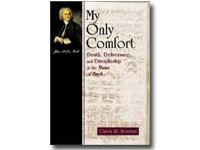My Only Comfort: Death, Deliverance, and Discipleship in the Music of Bach (Calvin R. Stapert, 2000)

Most people, even most non-musicians, probably know that Johann Sebastian Bach was a superb musician, a prolific composer, and a committed Christian. What we non-musicians don’t know, however, is how to enjoy his music thoughtfully and deeply, beyond simply listening to a piece and taking in whatever seems obvious at the moment. Now, thanks to Calvin Stapert, professor of music at Calvin College, our appreciation of Bach’s music can be enriched. In his new book My Only Comfort, Stapert uses the Heidelberg Catechism to help us understand the Christian world view expressed so wonderfully in Bach’s compositions.
Now, readers with some knowledge of the Reformation will notice a bit of a problem here. Bach was a committed Lutheran and the Heidelberg is a Reformed, not a Lutheran catechism. In fact, as Stapert notes, not only is there no evidence that Bach was even acquainted with the Heidelberg, there is some evidence that Bach, as a committed Lutheran, held some anti-Calvinist views. In his library was a book, Anti-Calvinismus, which summed up its argument this way: “We have shown that the ‘reformed’ doctrine overthrows the foundation of belief and therefore deserves to be condemned.” Stapert uses the Heidelberg, nevertheless, because it is the catechism he knows best, and though it is a Calvinist document, it expresses the heart of the “mere Christianity” which flowed from the Reformation.
Stapert’s book title comes from the first question of the catechism. “What is your only comfort in life and in death?” Answer: “That I am not my own, but belong body and soul, in life and in death to my faithful Savior Jesus Christ. He has fully paid for all my sins with his precious blood, and has set me free from the tyranny of the devil. He also watches over me in such a way that not a hair can fall from my head without the will of my Father in heaven: in fact, all things must work together for my salvation. Because I belong to him, Christ, by his Holy Spirit, assures me of eternal life and makes me wholeheartedly willing and ready from now on to live for him.”
After introducing the reader to Bach’s life and work, Stapert walks us through a number of his compositions in detail using the three main sections of the Heidelberg Catechism as an outline. “I hope that by providing,” Stapert writes, “key doctrinal statements from the Catechism, relevant Scripture passages, literal translations, and commentary on the texts and music, this book will make Bach’s theologically astute, artistically masterful, and religiously devout works more understandable for many listeners and hence make them more available as means for instruction, edification, and devotion.”
This is not a book that can be dashed through quickly, especially by non-musicians. It is, rather, a lively, interesting, and well-written textbook designed to help us understand, reflect on, and enjoy serious music. It requires a bit of work, but the effort is well worth it. I can imagine small groups using My Only Comfort together, occasionally planning an evening of listening to Bach and discussing one of the chapters of the book. Musicians can help the rest of us understand the more technical or detailed aspects of Stapert’s commentary. And churches can use My Only Comfort to enrich their congregational worship which would please the author, no doubt, since the book is part of the Calvin Institute of Christian Worship Liturgical Series “designed to promote reflection on the history, theology, and practice of Christian worship and to stimulate worship renewal in Christian congregations.”
We recommend My Only Comfort to you. Be warned though: if you purchase and read this book, you will likely discover it is God’s will to also purchase a number of CDs.

